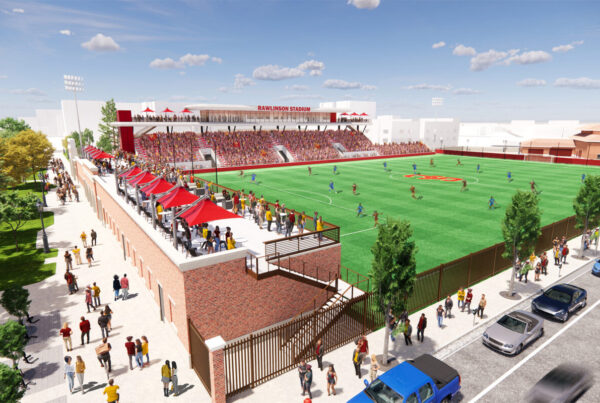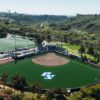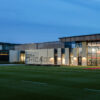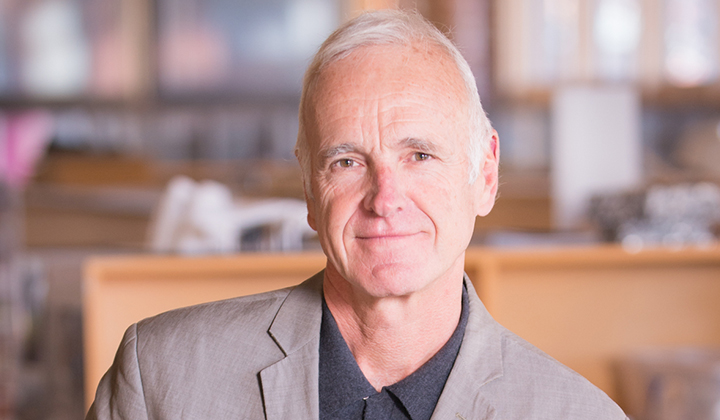Article written by Forum Reporter, Jeff Kolpack; courtesy of INFORUM.
The architecture firm designing the Bison Indoor Football Facility likes to think big. At its basic principle, the Nodak Insurance Company Football Performance Complex is a very large indoor empty space. Making something interesting out of that is the task of the architects, something Doug Osborn is very familiar with.
He’s a senior associate for Crawford Architects LLC out of Kansas City, the firm that is designing the structure along with Foss Architects and Interiors in Fargo. Foss is doing a lot of the local work, from helping integrate the surrounding athletic facilities to match the football indoor facility to just something as simple as being in the same city as the client. Crawford is doing the heavy lifting of the design, most of it being on the front end of the project.
“Often it’s a high mass of a facility,” Osborn said. “That is the challenge of breaking down the scale of it relating to everything surrounding it.”
What’s going to surround the Nodak Football Performance Complex is the Sanford Health Athletic Complex and the Nodak Insurance Basketball Performance Center to the north. To the northwest is the Shelly Ellig Indoor Track and Field Complex. Preliminary drawings show the football facility to have a similar feel with the Ellig Complex and the SHAC.
“Every project is unique, making sure it fits with the surroundings,” Osborn said. “When you look at the existing architecture, you have to be mindful of the surrounding development. All of it has to be considered. It helps a large facility like this blend in with the site.”
The large facility is a $37.2 million (privately-raised) athletic component, expected to further raise the profile of North Dakota State football. The main, indoor field will have plenty of sideline space and a height of 75 feet at its peak. Osborn said most indoor practice facilities are usually 80 to 100 feet, with the Minnesota Vikings’ practice home having a height of 98 feet.
“What comes into play there is a cost factor,” he said. “The higher you go the more steel is required. It’s a balance we have to play there.”
Crawford is no stranger to indoor practice facilities. It designed the TCO Performance Center and Stadium, the Minnesota Vikings’ complex in Eagan, Minn. Their portfolio includes indoor football practice structures at South Dakota State and the Seattle Seahawks. It designed Camden Yards, the home of the Baltimore Orioles; CenturyLink Field, the home of the Seattle Seahawks; TCF Bank Stadium, the home of the Minnesota Gophers; and the renovation to Lambeau Field in Green Bay, Wis.
This company isn’t into thinking small.
“First, it comes down to the function to be primarily used in the facility, in this case the No. 1 priority is football,” Osborn said. “This is a multi-sport function so that’s a little unique. It will be built to allow several athletic programs to practice in the winter months.”
While football will have priority, NDSU’s baseball, softball and golf teams will be able to take advantage of netting systems to train in their respective sports. Precast panels in the lower sections and metal panels above that height will be used for durability.
Where the creativity of the project comes into play is in the subsidiary sections of the building; such as the weight room, locker rooms, meeting rooms, and sports medicine areas. “The other components complement the indoor facility,” Osborn said. “The facility has an additional programmatic function, we’re able to use the lower mass against the higher mass.”
The NDSU project will incorporate a pre-engineered metal building system, which Osborn said is a more economical way of going about it but there is also a loss of stiffness to the structure. “What I mean by that is the building tends to sway a little more back and forth,” he said. “You have to accommodate that movement. Expansion capabilities have to be taken into consideration and taken into account. You don’t see it. Nobody sees this thing moving. We’re talking fractions of an inch.”
Groundbreaking is expected in July with a construction timeline of 13 to 15 months. It will also include a new outdoor lighted turf practice field. Seven garage doors will connect the indoor and outdoor fields in times of good weather. And there are plenty of avenues for natural light to find its way inside.
“At night it will take on a different appearance than in the day,” Osborn said. “That translucent system, the ability to bring in natural light in the day and not rely on artificial light, is a pretty cool element in itself.”













